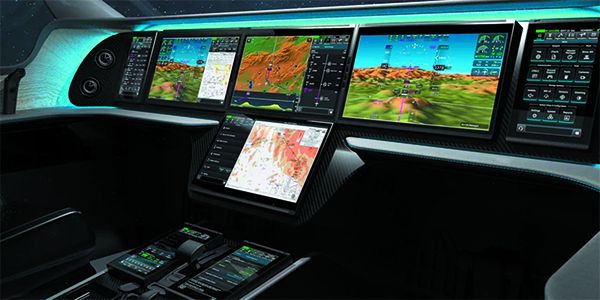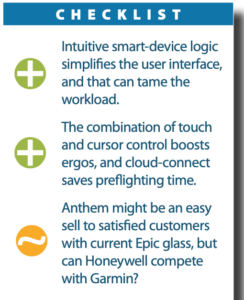
If you think those features are a recipe for building the ultimate futuristic flight deck, you have it right. And even in a world where everything is connected over the internet, you might not expect to be able to remotely connect to the cockpit anytime, anyplace. But you can.
That’s exactly what Honeywell has planned for Anthem—a fresh system it quietly revealed in private at the NBAA-BACE convention in Las Vegas this past October.
From what I saw during a nicely presented demo from Honeywell’s Jason Bialek in a full-sized flight simulator, the company is serious (and ambitious) about putting Anthem toe-to-toe with Garmin’s integrated systems for a wide range of applications. We’re talking small Cessnas to big Gulfstreams. Here’s are the major talking points and a look at standout features.
THINK AUTONOMY

Honeywell Anthem (don’t call this a BendixKing product—it’s not from that division and Honeywell makes that point clear) isn’t a warmed-over avionics suite. It’s a clean-sheet design with advanced capabilities that are right at home in the highest-end business jets (some not seen from any other manufacturer), but also has features that can serve turboprop and lower-end piston applications. Moreover, Anthem is a soup-to-nuts suite that will eventually lead to full autonomous capability, says Honeywell.
There’s a fully integrated autopilot/flight control system with takeoff and landing assistance, autothrottle, 3D airport surface graphics, a web browser and always-on cloud connectivity for third-party app interface, plus 24/7 access to the system from anywhere in the world. More on that in a minute.
The demo suite I saw had four 15.6-inch touch displays (plus two smaller touch controllers) with 2K resolution, although Honeywell plans to scale the size down to suit smaller panels. It might even bring a version to the experimental market, but that might be further down the road. Forward-fitting comes first.
It will offer 17.3-, 14.6- and 13.3-inch versions, based on individual customer demand. Honeywell says that the modular design of the system (and smaller footprint of remote components) makes an Anthem suite nearly 50 percent lighter than other integrated avionics systems. That’s one reason why the system will be easy to scale for a wide range of airplanes, with a customizable user control set.
And depending on the application, the suite can be controlled by a CCD, or cursor control device. CCDs have long been the standard in modern jets, and it’s how existing later-model Honeywell Epic avionics—including the Apex system in Pilatus models—are operated. For the Anthem, you’ll be able to command them via touch and with a CCD. There are no buttons or knobs. Anthem even has electronic onscreen circuit breakers.

CLOUD CONNECTED, PILOT CONFIGURABLE
This doesn’t mean that Anthem’s critical systems are always connected to the internet. Instead, a virtual cloud connection means the system can always see what pilots and maintenance people have loaded remotely after logging in to the system—things like flight plans and configuring the system’s screen layout and windows, for example. The idea here is to save time setting up the cockpit beforehand so you can launch quickly and efficiently, with less time spent on data entry.

Plus, you can see things like fuel quantity, oil status and tire pressure without having to be at the airplane. The concept isn’t exactly new. Cirrus has already enabled remote access to its models with the Cirrus IQ program, via access with a cellular transceiver installed in the aircraft. Honeywell said the Anthem will initially communicate via satcom, although it’s designed for agnostic connection.
Another part of the system’s connectivity is the Secure Cockpit Browser, or SCB. This enables Anthem to use third-party applications. This includes windy.com for access to weather cameras, plus ForeFlight’s web application—which was actively running during my demo.

Once seated behind all that glass, Anthem has a decent pilot interface master application, which allows the pilot to reconfigure the display windows on the fly. Maybe you want to custom configure checklists, expand windows for cockpit lighting and environmental systems, or simply move data around the displays. Some of this (mainly top-level critical data) will be locked in place by the aircraft OEM for a specific aircraft model, but the system still allows huge amounts of customization of data. Think in terms of moving icons around a desktop to your liking. The same concept applies to the pilot interface application.
NO STANDBYS REQUIRED
Even blinded by all that bright sprawling landscape of glass, I immediately noticed that the demo suite didn’t have standby flight instruments—something that every integrated avionics suite has. How will Honeywell get away with that, especially given the rigors of the FAA TSO and type certification process?
“We are working with aircraft OEMs to bring an architecture to market that doesn’t require standby instruments because of the way we designed the sensor configuration,” Jason Bialek said, and he’s convincing. Digging deeper into the architecture reveals plenty of belt and suspender backup and automation among the LRUs. As one example, and depending on the display configurations, if the internal AHRS, display generators or pitot static air data computers (there are two of each as you’d expect) were to fail, a third system would take over and automatically present the standby flight instruments on the screens. I suspect there will be some compromises once the system is approved, and aircraft OEMs will have their own ideas about how backup flight data should be presented. Still, Honeywell’s experience in high-end biz jet cockpits should boost confidence in overall reliability.

PILOT BACKSTOP, TOO
Honeywell says there will be differences between the general presentation of Anthem’s data for jet cockpits compared to smaller piston applications and that makes sense. But, the fundamentals of putting situational awareness front and center will remain the same no matter where the system is installed. Anthem’s feature set with intensive 3D synthetic vision paints a deep and realistic image of the runway and airport surface environment.
With a detailed birds-eye view of the airport environment, and taxi guidance, you’d have to be asleep at the controls to taxi onto the wrong runway or taxiway.
As an example, if you’re cleared to the FBO via E6, F6 and H, simply type that taxi clearance/destination in (just as you would a flight plan) and it draws a destination flag on the surface map, while drawing a taxi path to follow over the synthetic surfaces.
Autothrottle capabilities aside, there’s even help with takeoff, landing and braking. In a rejected takeoff situation, Anthem could help eliminate the disasters we’ve seen in recent (and past) jet takeoff wrecks. You’re hauling down the runway quickly headed to the 110-knot V1 and you abort at 80 knots. The synthetic view on the PFD shows precisely the spot down the runway where the aircraft can stop (or rotate if you decide to go), based on the current braking conditions. There’s also landing overrun protection.
Modulate the brakes on landing to make a high-speed turnoff, as another example, and a surface marker predicts in real time where you’ll actually be in relation to the turnoff. If a runoff is imminent, you’ll get audible and visual warnings—“Increase Braking, Max Brakes, Max Reverse,” in gradual alerting levels based on braking. Based on thrust level and speed, the display transitions from exocentric (birds-eye) to egocentric (inside the aircraft) views. The pilot can also manually take control of the display views, based on preference. Without a doubt, Honeywell’s 3D Runway Overrun Alerting and Awareness System, or ROASS, is intuitive and intelligent.
Inflight, there’s 3D waypoint symbology, selectable traffic target tags (tap the traffic symbol for more info), low-speed alerts with automatic autothrottle engagement and turn radius info based on bank angle—which can be helpful when flying traffic patterns. And when hand-flying, there’s the useful speed-target symbology I’ve grown to like on other Honeywell systems, where the onscreen flight path marker shows where the aircraft will be at a given waypoint in the flight plan. When descending for the airport or approach segment, for example, a magenta speed-target bucket up on the horizon fluctuates based on pitch and power/thrust. Flying by flight path markers is hardly new, but Honeywell takes it one useful step further.

CRITICAL TIMES AHEAD
The next and critical step for Honeywell is to convince aircraft OEMs and the aftermarket—through the dealer network—that Anthem is a worthy alternative to Garmin’s G3000/5000 and even the aging G1000/NXi platforms. In my view, a thorough demonstration will certainly be convincing enough that this system is indeed the flight deck of the future. While I didn’t fly with Anthem in the real world, the simulator proved it’s the most forward-thinking suite I’ve seen to date—seemingly years ahead of others in appearance, ergos and safety backstop, thanks to display design and the familiar smart-device feature set.

Saying that, there’s no question that Anthem will be greeted with a healthy level of skepticism (perhaps not so in the UAV market where it’s already earning business), and I think that’s pretty unfortunate. The AeroVue, which is an integrated flight deck derived from the Honeywell Primus Epic and Primus Apex systems, never really gained traction in the aircraft OEM and aftermarkets, and some of the feature set trickles into the Anthem—not a bad thing, based on the AeroVue I’ve flown in King Air applications.
But what about the AeroVue Touch—the lower-cost integrated touchscreen suite for retrofit and for new aircraft? This suite, which has decent graphics, a friendly user feature set and good third-party avionics compatibility, was long in development and won the 2018 Good Design Award in the Transportation category, but isn’t exactly flying off the shelves based on the avionics shops I talked with. Honeywell said the Anthem will eventually replace the AeroVue Touch, and it’s targeting the 2025 time frame for release into the aftermarket. No pricing information has been announced, which will highly depend on configuration and application, and Honeywell didn’t say how Anthem might drop into existing late-model Epic and Apex suites.
Based on my demo, I think Honeywell deserves respect for engineering the fresh and ultramodern Anthem, and even more respect for going after a market long dominated by Garmin.
There’s more on the Anthem project at www.aerospace.honeywell.com
See a video of the Honeywell Anthem at http://tinyurl.com/j95ht2a

